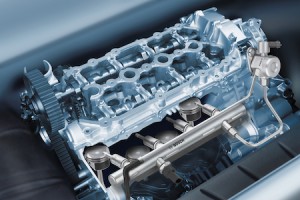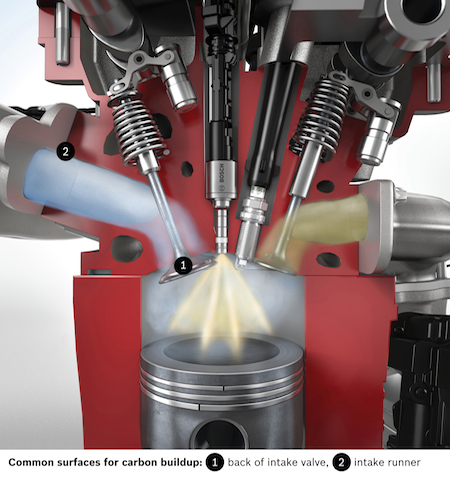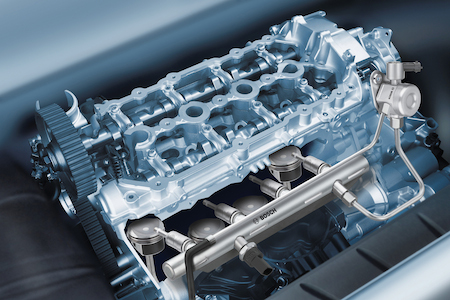Courtesy of BOSCH
 BROADVIEW, Ill. – Driven by strict emission laws and a growing demand for low fuel consumption, an increasing number of vehicles equipped with gasoline direct injection systems (GDI) are now being seen on roads today.
BROADVIEW, Ill. – Driven by strict emission laws and a growing demand for low fuel consumption, an increasing number of vehicles equipped with gasoline direct injection systems (GDI) are now being seen on roads today.
However, a common complaint about these vehicles has been the buildup of carbon deposits inside the cylinder head. What causes carbon deposits in GDI-equipped vehicles?
The cause of carbon buildup can vary by vehicle make, as engine management systems can mitigate the carbon buildup in certain vehicles by something as simple as an ECU update. Essentially, carbon buildup occurs due to a combination of low quality fuel, short, frequent cold weather trips or positive crank case ventilation which may leave an oily layer around the intake valve. These factors, in conjunction with the operating tem-peratures of the engine casing, lead to a buildup of carbon deposits. Timing may also have an effect if the intake valve stays open long enough to be ex-posed to unburned fuel.
 Finally, the location of the GDI injectors in the cylinder head plays a significant role in carbon buildup because it does not allow for the fuel sprays to reach the back of the intake valve, making it difficult to keep the intake runners and valve clean. What is the impact of carbon buildup on drivability, performance, emissions and fuel economy? With regard to drivability, one of the more common symptoms is a lack of power, espe-cially when driving at higher speeds. Other symptoms could include cold stalling and cold-start difficulties, including rough running when the engine is cold.
Finally, the location of the GDI injectors in the cylinder head plays a significant role in carbon buildup because it does not allow for the fuel sprays to reach the back of the intake valve, making it difficult to keep the intake runners and valve clean. What is the impact of carbon buildup on drivability, performance, emissions and fuel economy? With regard to drivability, one of the more common symptoms is a lack of power, espe-cially when driving at higher speeds. Other symptoms could include cold stalling and cold-start difficulties, including rough running when the engine is cold.
There is also the possibility of a failed NOX emissions test and/or excessive ping on acceleration. In some cases, carbon buildup may cause one or more cylinder misfire codes (P030X) which will result in fuel inefficiency and poor performance. This occurs when an insuffi-cient number of cylinders fire while the vehicle is in operation. If the presence of carbon deposits is not detected early enough or the buildup is severe, the check engine light may turn on and the vehicle is likely to fail inspection. How is soft carbon different from hard carbon? How long does it take for soft carbon to turn into hard carbon? Soft carbon is sooty and more easily dissolved than hard carbon and can be remedied with additives, while hard carbon is baked on and is more labor intensive to address.
Hard carbon requires manual cleaning such as media blasting. How long it will take the soft carbon to turn to hard carbon will depend on the motorist’s driving habits and the initial cause of the buildup. What steps can technicians take to remove soft carbon and/or hard carbon? Soft carbon can be addressed by following the manufacturer’s preventative mainte-nance schedule along with a fuel additive that may be added to the vehicle’s fuel sys-tem before warm up.
The technician can also utilize a fogger system via the throttle body. The fogger is connected to a pressurized dispenser filled with a chemical blend formulated to dissolve baked-on carbon deposits from the valves and passageways. For hard carbon, the process is more involved. The most common procedures call for removing the intake manifold to expose the head’s ports, and rotating the engine by hand in its normal direction of rotation so that the intake valves for one of the cylinders are completely closed, then utilizing some form of media blasting. Can checking certain components when a car comes in for service help to avoid carbon buildup? For example, the high pressure fuel pump, pressure sensor, etc?
Checking spark plugs is a great way to start because it may help to reduce the amount of unburned fuel in the combustion chamber. Follow the regular maintenance schedule. Look for telltale signs for product failure such as the check engine light and poor vehicle performance. Also, oil changes are extremely important. Customers should always use the manufac-turer’s specified oil to prolong the life of GDI components such as the high pressure fuel pump. If the wrong oil is used or the vehicle does not follow the manufacturer’s recom-mended oil change intervals, it may result in the failure of the high pressure pump or of other GDI components. What should technicians do to prepare to service and repair GDI systems? Technicians should educate themselves on the vehicle manufacturer’s maintenance schedule to ensure prolonged life of GDI system components. They should especially learn to identify system failure symptoms so they can be proactive in sharing the infor-mation with their customer when servicing these vehicles.
Learning about the tools needed to service these vehicles is also important. At the end of the day, technicians are savvy and will build on the principles they already know. By doing so, they will sim-plify their approach to servicing a complex system. Should a technician educate customers on the nature of the GDI system and guide them in taking the right steps to avoid buildup of carbon deposits? Yes, I would highly recommend that technicians share the knowledge with their custom-ers that bring in GDI-equipped vehicles for service. Technicians can advise them to fol-low the manufacturer’s schedule for service, and take a few proactive measures to have their vehicle inspected between services.
GDI is a great technology and if serviced properly is nothing to be intimidated by, as a consumer or as a technician. In fact, techs can help their customers enjoy driving a GDI-equipped vehicle.
For information on GDI, visit: http://www.boschautoparts.com/auto/fuel-injectors/gasoline-direct-injection.








